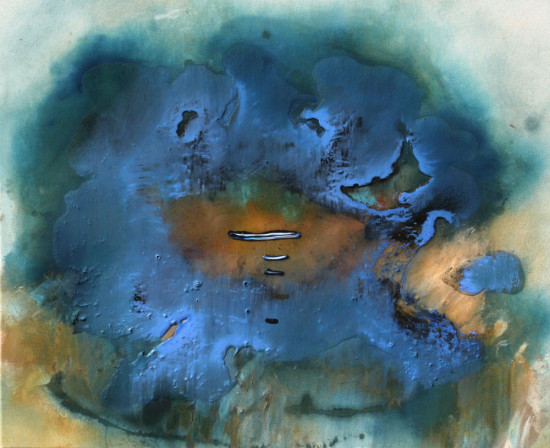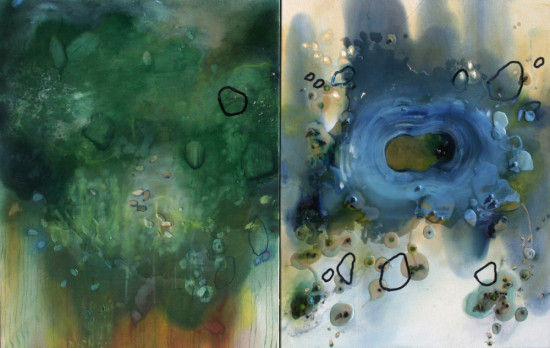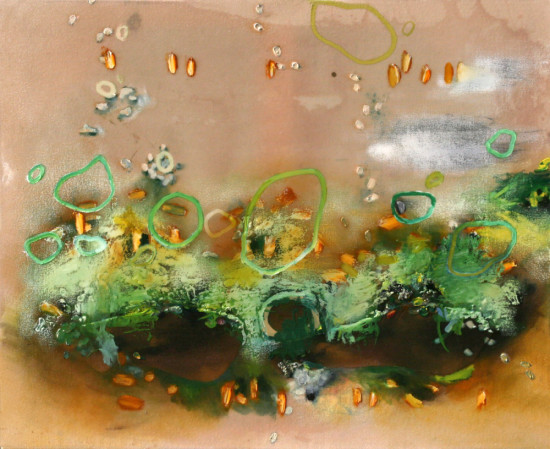One of the biggest success stories to come out of Bucktown Center for the Arts is Emily Christenson and her nature-inspired works. Some early visitors to doeGallery were impressed with her art and took a postcard of one of her paintings back to a favorite gallery in Washington, DC. Within a year, Christenson's work was hanging on the walls at the Fine Art & Artists (FAA) Gallery in Georgetown along with some of the big names of the 20th Century. Luck certainly played a role in Christenson's story, but if the work hadn't been so good and so captivating, it wouldn't have gone any further than being a souvenir postcard.
At FAA, Christenson enjoyed two years of strong sales, a solo show of her work, and a review in the Washington Post. She was preparing a body of work for her second solo show, Rivers & Rain, Pieces of Denali, when she got a call that the gallery was closing after 15 years.
More than a year later, Christenson is premiering both a new Bucktown gallery/studio (called "e|c") and the 10 works that make up Rivers & Rain, Pieces of Denali. The show runs through the end of December, and the gallery is in the southeast corner on the second floor.
A typical work is Untitled Dialogue: Savage River Thaw. The base layer of paint, which was primarily generated out in nature, is a subtle flowing mass of aqueous color shifts from pale greens into forest greens, aqua blues, ultramarine, and sandy ochres. Resting on top is a mass of resin that gives the painting an eternally "wet" look. The resin layer allows Christenson to "float" select passages of paint above the base image. Visually it captures the sensation of a reflection on the surface of water rather than paint being stacked on top of more paint.
She starts out in the open, usually near a body of water, with water-soluble oil paint. Christenson works some paint onto the unstretched canvas and then lets the paint and water interact (with drips and spatters of water, or by briefly submerging a canvas and then letting the water pool up or run off). While the canvases are wet, she leaves them out in the elements to be worked on by natural forces such as falling pine cones and leaves, raindrops and runoff, scrapes with stones, and the gentle stab of blades of grass.
Back in the studio, Christenson responds to the marks on the canvas. She scrapes, dabs, smears, and washes paint onto the surface to produce a finished piece. She also draws with great reverence from the impression that nature left on her. Keeping in touch with that outdoor experience and maintaining a balance between nature and studio allow Christenson to create works that feel honest and unified.
The risk Christenson runs by having an image-creation process with two distinct phases is discontinuity between the contributions in nature and the larger expanse of studio time. For the majority of the works (including Untitled Dialogue: Savage River Thaw), she avoids that trap, as there is no clear demarcation between what happened outdoors and what happened indoors. When you consider that the amount of studio time on these works was lopsided compared to her normal process (she had nearly an extra year to work on the Denali show in the studio), it's impressive how organic, vital, and spontaneous these works appear.
The diptych Untitled Dialogue: Ripple Effect, on the other hand, is a rare instance of the studio work overwhelming a painting, resulting in a piece that feels conscientious about being "art" and curtailing its vitality.
The left panel has intricate passages of subtle green shifts encased under a flow of resin. The shiny and smooth resin contrasts beautifully with the textured strokes underneath and captures that sense of a clear barrier that you get with calm water. Both above and below the the surface are thick dabs of paint, not unlike shifting motes of reflected sunlight or iris petals lazily wandering around in an aquatic dream.
The right panel captures the splash/ripples alluded to in the title. There is a centered flattened blue tunnel that bleeds out into some muted greens and dull peach circles. The resin becomes a clear pool in the center with satellite pools dotting the surface. Many of the pools have been conspicuously impregnated with small pine cones. The placement of the pine cones and the seemingly more calculated "nature" of the piece makes it come across as an artificial studio creation, and it's discordant with the rest of the show.
Untitled Dialogue: (foliose handwriting) is more typically harmonious and seamless. The resin covers the majority of the picture, with textured surprises of color poking out of the clean veneer, like defiant vegetation daring to compromise the crisp surface of a pond. An energized dialogue between warm tones of peach, umber, orange, and yellow is countered superbly with some minimal stabs, slashes, and blots of barely cool grass greens and mint greens. The majority of the image surface is made up of the gentle undulations of the warm tones, but the mark-making techniques with the cool colors are full of intense activity and offer a satisfying balance.
e|c is located on the second floor of the Bucktown Center for the Arts, 225 East Second Street in downtown Davenport.
For more information on Emily Christenson, visit EmilyChristenson.com.











